Baby Rainbow Sampler Blanket 2
18.Jul.24 / Kirsten BalleringThe Baby Rainbow Sampler Blanket 2 is a small version of the Big Rainbow Sampler Blanket 2. It features all the different stitches used in the original blanket, just smaller. It's a great project for an ambitious beginner who wants to learn more crochet stitches and is perfect for gifting to your loved ones. This blanket is a journey in itself!
You can find the other pattern parts here:
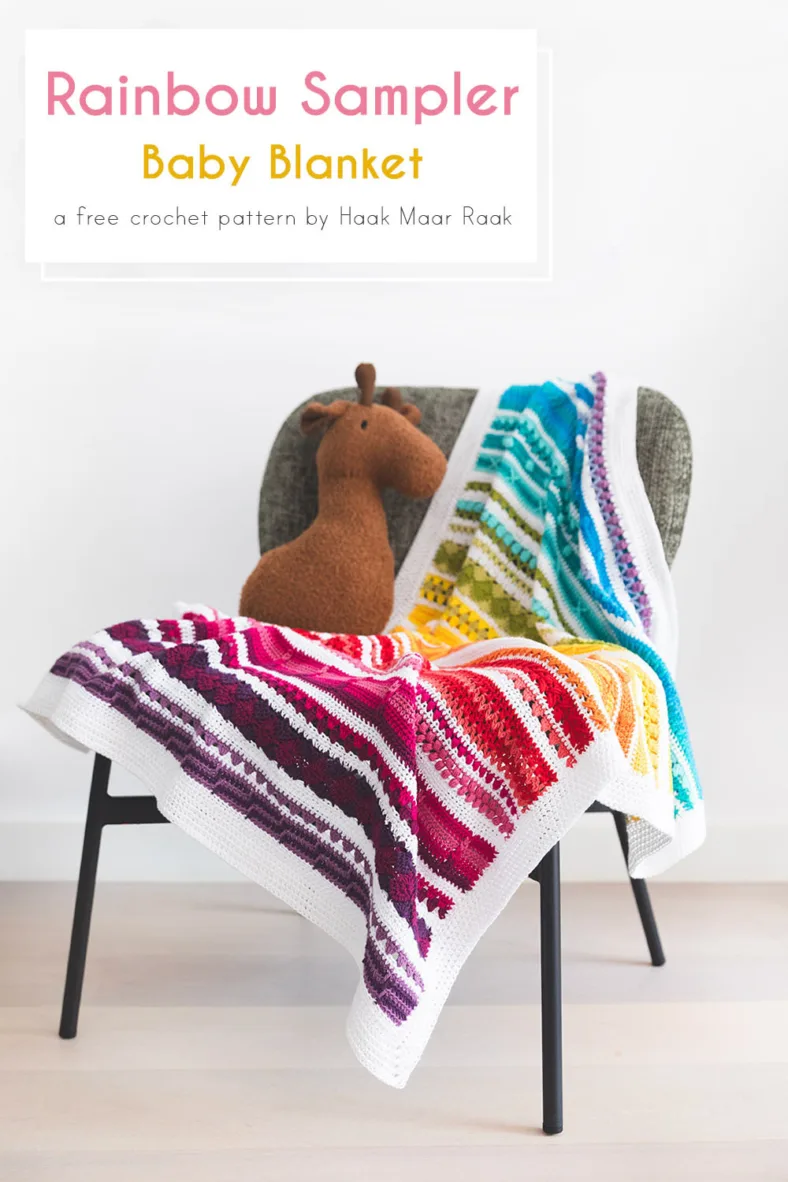
Materials and preparation
The pattern is available in two colourways: A Organicon rainbow colourway, and a Catona gradient colourway. Instructions for both colourways are included in the pattern. Be aware that they do use different amounts of each colour for each version.
Yarn
Organicon Rainbow
Scheepjes Organicon (100% Soft Organic Cotton, 50g/170m)- Colour A: 219 Oxygen x 4 balls
- Colour B: 259 Lucky Heather x 1 ball
- Colour C: 257 Perfect Plum x 1 ball
- Colour D: 246 Dahlia x 1 ball
- Colour E: 247 Swaying Tulip x 1 ball
- Colour F: 248 Pink Elephant x 1 ball
- Colour G: 245 Amaranth x 1 ball
- Colour H: 244 Red Rose x 1 ball
- Colour I: 224 Deep Tangerine x 1 ball
- Colour J: 238 Happy Sunflower x 1 ball
- Colour K: 239 Baby Chick x 1 ball
- Colour L: 213 Sapling x 1 ball
- Colour M: 228 Olive x 1 ball
- Colour N: 215 Bright Ocean x 1 ball
- Colour O: 264 Happy Thoughts x 1 ball
- Colour P: 268 Sleepy Cyan x 1 ball
- Colour Q: 267 Ticklish Turquoise x 1 ball
- Colour R: 255 Bluebell x 1 ball
Catona Gradient
Scheepjes Catona (100% Cotton, 50g/125m)- Colour A: 106 Snow White x 6 balls
- Colour B: 522 Primrose x 1 ball
- Colour C: 208 Yellow Gold x 1 ball
- Colour D: 386 Peach x 1 ball
- Colour E: 410 Rich Coral x 1 ball
- Colour F: 256 Cornelia Rose x 1 ball
- Colour G: 519 Fresia x 1 ball
- Colour H: 222 Tulip x 1 ball
- Colour I: 246 Icy Pink x 1 ball
- Colour J: 172 Light Silver x 1 ball
- Colour K: 385 Chrystalline x 1 ball
- Colour L: 253 Tropic x 1 ball
- Colour M: 510 Sky Blue x 1 ball
- Colour N: 399 Lilac Mist x 1 ball
- Colour O: 520 Lavender x 1 ball
- Colour P: 398 Colonial Rose x 1 ball
- Colour Q: 251 Garden Rose x 1 ball
- Colour R: 413 Cherry x 1 ball
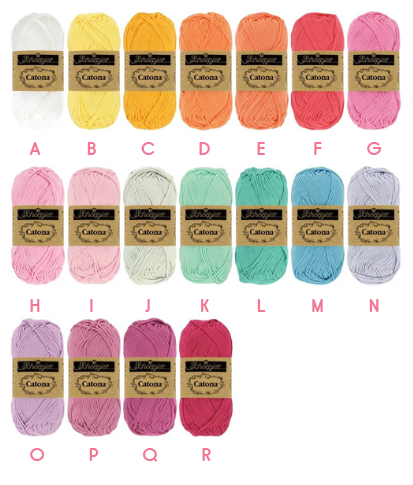
Shop the yarn!
Do you want to make this blanket? You can find the yarn for this blanket in several stores, such as:
Crochet hook
3.5mm (US size E/4) for both versions.
Measurements
Organicon blanket measures 110 x 85cm (43 x 33½in) after blocking. Catona blanket measures 122 x 94cm (48 x 37in).
Gauge/tension
Gauge is not critical for this pattern. It’s almost impossible to match gauge for all the different stitches, and since you’ll be making the blanket in one go you don’t have to worry too much about tension changing over time. We’ll have enough yarn leftovers to be flexible. If you want to make sure your blanket measurements are similar to the sample blanket, try to match this gauge for Organicon: 17 hdc and 16 rows measure 10 x 10cm (4 x 4in) with a 3.5mm hook. For Catona: 15 hdc and 14 rows measure 10 x 10cm (4 x 4in) with a 3.5mm hook.
Check your gauge by working a gauge square:
With Colour A, ch26.
Row 1 (RS) Starting in the second chain from hook, work 25hdc, ch1, turn. [25 hdc]
Rows 2-15 25hdc, ch1, turn.
Row 16 25hdc, cut yarn.
Take the measurements in the center of your square (so try not to include the top or bottom row, or the most left or right stitches). Measurements are more reliable that way.
Notes
- The pattern for this blanket is long. To keep track of where you are, I’ve divided it into different parts. Each part introduces a new section with Techniques and also contains a crochet diagram.
- In most rows you’ll make a ch1 before turning your blanket. This is a turning chain and does not count as a stitch. If you find a ch1 is too small, you can also make a ch2. This depends on how tight you crochet.
Abbreviations (US terms)
- BLO: back loop only
- ch: chain(s)
- dc: double crochet
- dc3tog: double crochet 3 stitches together to decrease the stitch count by 2: (yarn over, insert hook in stitch, yarn over, pull up loop, yarn over, pull through first two loops on hook) once in each of three stitches, yarn over, pull through all loops on hook
- dc7tog: double crochet 7 stitches together to decrease the stitch count by 6: (yarn over, insert hook in stitch, yarn over, pull up loop, yarn over, pull through first two loops on hook) once in each of seven stitches, yarn over, pull through all loops on hook
- FL: front loop
- hdc: half double crochet
- RS: right side
- sc: single crochet
- ss: slip stitch
- s(ts): stitch(es)
- tr: treble crochet
- WS: wrong side
Repeat formats
- *….; rep from * once/twice/3x Crochet the instructions after * and then repeat that section a further number of times as indicated.
- (…) once/twice/3x Crochet the instructions between brackets the total number of times indicated.
- […] Indicates the amount of stitches at the end of a row or round.
- (…) in same st/sp Indicates that all instructions between brackets are worked in the same stitch or space.
Colour layout
Adjusting the size of the baby blanket
Lengthwise, it’s really simple: Add or remove more sections. Widthwise it’s simple too, but benefits from some background info.
Short explanation
You can subtract or add multiples of 24 to the blanket to change size. You could increase the size by making 169 hdc, or 193. Or make it smaller with 121 hdc. Every 24 stitches measure ~ 13cm (5in) in the Organicon blanket and ~14cm (5½in) in the Catona one.
Long explanation
You might be wondering: 145 is not divisible by 24? That’s correct. But 144 is. I added an extra stitch because some stitch patterns need a final ‘+1’ stitch. Imagine: A Catherine Wheel consists of a stitch repeat of 6 + 1. Without the +1, you wouldn’t have a stitch to adhere your final Catherine Wheel. It would just flop about.
24 is a great number because it’s divisible by many other numbers: 1, 2, 3, 4, 6, 8 and 12. It means that if you have stitches with these stitch repeats, you will only have to adjust the number of repeats, not the actual repeat instructions.
You see, every pattern row in this pattern follows the same formula: (the part before the first stitch repeat) + (stitch repeat) + (the part that says how often you need to repeat the stitch repeat) + (the part after stitch repeat, this often contains the ‘+1’ stitch). And I ensured every stitch in this blanket has a ‘stitch repeat’ that fits in 24.
When a stitch repeat fits in 24, you only have to adjust the third of these four components: the part that says how often you need to repeat the stitch repeat. The part afterwards usually sorts itself: if you have a stitch repeat of 12 and only 5 stitches left, you can be pretty sure you reached the end of your row. So, there's no need to count out all the repeats!
Part 1 Weekly overview

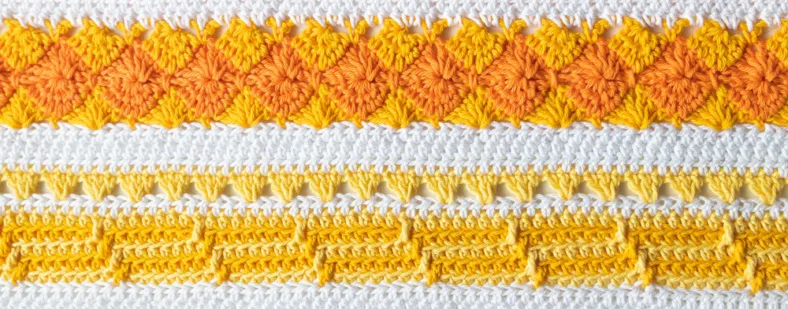
Techniques
To keep the pattern organised, I placed the techniques on separate pages:
Crochet pattern
Foundation rows (Rows 1-2)
We will set up the blanket with a couple of solid, white rows.
With Colour A, ch146.
Row 1 (RS) Starting in second chain from hook, 145hdc, ch1, turn. [145 hdc]
Row 2 (WS) 145hdc, ch1, turn. [145 hdc]
Apache tear section 1 (Rows 3-8)
The Apache tear is a decorative stitch that can be used in many ways. It lends itself to all stitch multiples, so you can adapt its basic concept to pretty much any idea!
Row 3 (RS) Join Colour B with a ss in the back loop of the first stitch, ch1, 1hdc BLO in the same stitch, 144hdc BLO, cut yarn, don’t turn. [145 hdc]
Row 4 (RS) Join Colour C with a ss in the back loop of the first stitch, ch1, 1hdc BLO in the same stitch, 5hdc BLO, *1dc in FL of stitch two rows below, skip next stitch on current row, 7hdc BLO; repeat from * another 15 times, 1dc in FL of stitch two rows below, skip next stitch on current row, 10hdc BLO, cut yarn, don’t turn. [17 dc, 128 hdc]
If you feel grabbing the front loop only is too loose, you can grab both loops of the stitch as well, or even the loop below the front loop.
The ends of the Apache tear sections tend to flare a bit, which we’ll sort out with blocking later. If you feel the flare is too prominent, you can start and end each row with a sc in the final stitch instead of an hdc.
Row 5 (RS) Join Colour B with a ss in the back loop of the first stitch, ch1, 1hdc BLO in the same stitch, 6hdc BLO, *1dc in FL of stitch two rows below (stitch immediately left from the previous dc), skip next stitch on current row, 7hdc BLO; repeat from * another 15 times, 1dc in FL of stitch two rows below, skip next stitch on current row, 9hdc BLO, cut yarn, don’t turn. [17 dc, 128 hdc]
Row 6 (RS) Join Colour C with a ss in the back loop of the first stitch, ch1, 1hdc BLO in the same stitch, 7hdc BLO, *1dc in FL of stitch two rows below (stitch immediately left from the previous dc), skip next stitch on current row, 7hdc BLO; repeat from * another 15 times, 1dc in FL of stitch two rows below, skip next stitch on current row, 8hdc BLO, cut yarn, don’t turn. [17 dc, 128 hdc]
Row 7 (RS) Join Colour B with a ss in the back loop of the first stitch, ch1, 1hdc BLO in the same stitch, 8hdc BLO, *1dc in FL of stitch two rows below (stitch immediately left from the previous dc), skip next stitch on current row, 7hdc BLO; repeat from * another 15 times, 1dc in FL of stitch two rows below, skip next stitch on current row, 7hdc BLO, cut yarn, turn. [17 dc, 128 hdc]
Row 8 (WS) Join Colour A with a ss in the first stitch, ch1, 1hdc in same st, 144hdc, cut yarn, turn. [145 hdc]
Granny Stripe section 1 (Rows 9-12)
The Granny Stripes have been used in the first sampler blanket. I enjoy these stitches as they’re a crochet staple and work up quickly.
Row 9 (RS) Join Colour B with a ss in the first stitch, ch3 (counts as first dc), 1dc in same stitch, *skip 2 stitches, 3dc in next stitch; repeat from * another 46 times, skip 2 stitches, 2dc in last stitch, cut yarn, turn. [47 Granny clusters with 3 dc, 2 clusters with 2 dc, 145 dc in total]
Row 10 (WS) Join Colour A with a ss in the first stitch, ch1, 1hdc in same st, 144hdc, ch1, turn. [145 hdc]
Row 11 (RS) 145hdc, ch1, turn. [145 hdc]
Row 12 (WS) 145hdc, cut yarn, turn. [145 hdc]
Catherine Wheel section 1 (Rows 13-18)
You might have seen the Catherine Wheel in my previous blanket, like the Granny Stripes. It’s a stitch that looks beautiful from the front and the back. It’s intricate and solid-looking, making it perfect to add to this blanket, too!
Row 13 (RS) Join Colour C with a ss in first st, 1sc in same st, *skip 2 sts, (3dc, ch1, 3dc) in same st, skip 2 sts, 1sc in next st; repeat from * another 22 times, skip 2 sts, (3dc, ch1, 3dc) in same st, skip 2 sts, 1sc in last stitch, cut yarn, turn. [25 sc, 24 3dc-ch1-3dc clusters, 48 spaces where you skipped 2 sts]
Row 14 (WS) Join Colour D with a ss in first st, ch3 (counts as first dc), dc3tog, ch7, skip ch-1 space, *dc7tog, ch7, skip ch-1 space; repeat from * another 22 times, dc3tog, 1dc in final st, turn. [23 half Catherine wheels, 2 quarter wheels (one on each end), 2 dc, 24 ch-7]
Row 15 (RS) Ch3 (counts as first dc), 3dc in dc3tog (there’s an ‘eye’ in the centre of the wheel, that’s where you’ll be working your stitches), 1sc over the ch7 of your previous row into the ch-1 space of Row 13, *(3dc, ch1, 3dc) in next dc7tog, 1sc over the ch7 of your previous row into the next ch-1 space of Row 13; repeat from * another 22 times, 3dc in final dc3tog, 1dc in last dc (the ch3 with which you started Row 14), cut yarn, turn. [23 half Catherine wheels, 2 quarter Catherine wheels (one on each end), 2 dc, 25 sc]
Since we’re only going to work one row of Catherine wheels, the next row will look like Row 14, but it will not be exactly the same. If you crochet 7 chains as the ‘top’ row of the Catherine wheel, you can imagine that all your next rows would have quite a big gap. Instead, we’ll be securing the chain to the Catherine wheels. This way, you can continue with the rest of your blanket without big gaps. Basically, we’re mirroring Row 13.
Row 16 (WS) Join Colour C with a ss in the first stitch, 1sc in same st, *ch3, dc7tog, ch3, 1sc in ch-1 space of Row 15; repeat from * another 22 times, ch3, dc7tog, ch3, 1sc in last dc (the ch3 with which you started Row 15). Cut yarn, turn. [25 sc, 24 dc7tog, 48 ch-3]
We’ll need to ensure we’re returning to 145 hdc in the next row. This means counting! Luckily, we can look to Row 13 for help. Each Catherine wheel took up 6 stitches (1 sc, 2 skipped stitches, a wheel, and 2 skipped stitches again). So we just need to make 6 stitches per Catherine wheel, plus the final stitch that we used to fasten the last wheel to get back to 145 stitches.
Row 17 (RS) Join Colour A with a ss in first st, ch1, 1hdc in same st, *2hdc in ch-3 space, 1hdc in dc7tog, 2hdc in next ch-3 space, 1hdc in sc; repeat from * another 22 times, 2hdc in ch-3 space, 1hdc in dc7tog, 2hdc in ch-3 space, 1hdc in last sc, ch1, turn. [145 hdc]
Row 18 (WS) 145hdc, cut yarn, turn. [145 hdc]

Diagram
Crochet Diagram Part 1
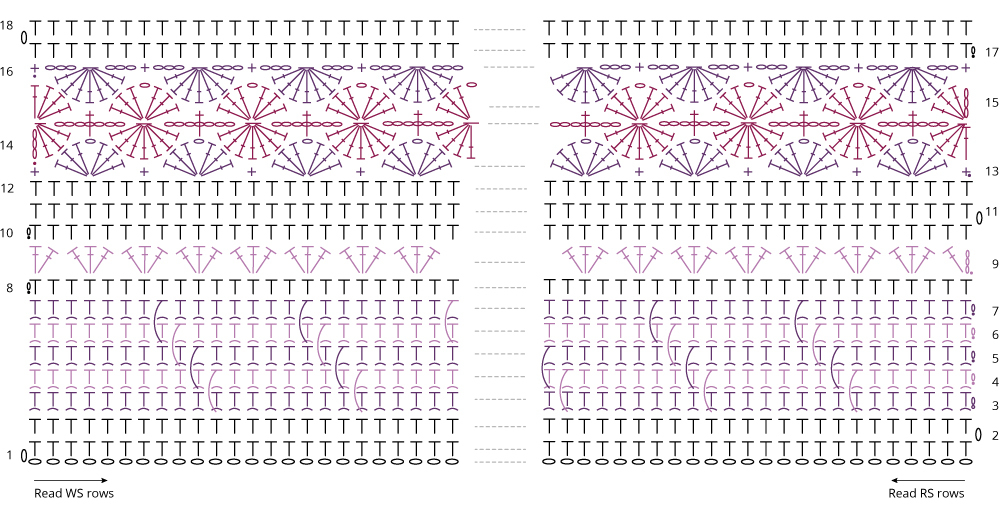
Key (US terms)
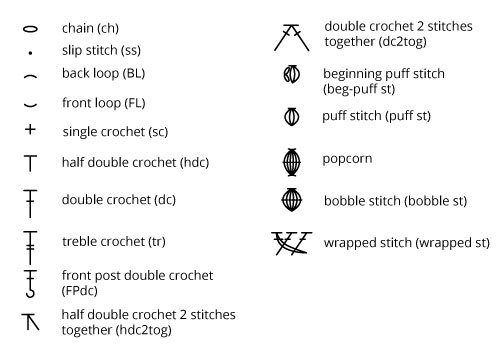



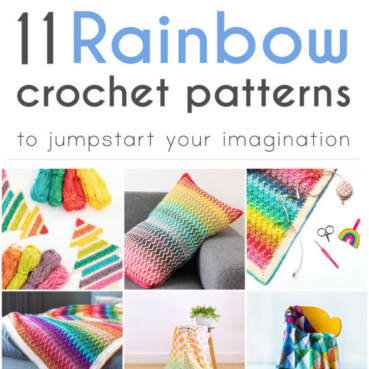
Comments